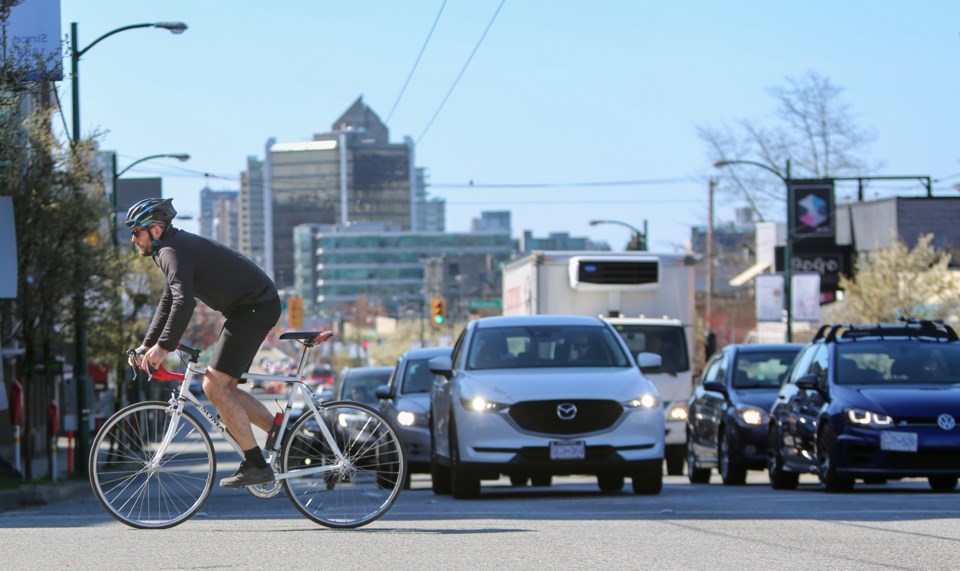The City of Vancouver is looking to develop new plans to guide the city’s present and future climate change-fighting work after determining the goal of reducing carbon pollution by 50 per cent by 2030 is likely unreachable.
Staff sounded the alarm in February 2023 about its concerns related to the council-directed goals to reduce emissions to 50 per cent by 2030 and be carbon neutral by 2050.
More than a year later, the message is the same.
In a July 23, staff has requested the go-ahead to proceed with developing new plans that include “achievable” goals and actions that are “cognizant of the city’s role and jurisdiction when it comes to climate action.”
The city currently has two plans that guide its climate actions: the Climate Emergency Action Plan (CEAP) and the Climate Change Adaptation Strategy (CCAS).
CEAP, approved in 2020, is a five-year plan aimed at cutting carbon pollution by 50 per cent by 2030. CCAS was updated in early 2024 as a two-year plan with the goal of increasing Vancouver’s readiness and resilience in the face of climate change.
“Given that both plans sunset in 2025, there is a need to develop new action plans to guide the city’s climate work to 2030 and beyond,” said the report, noting the goal would be to bring back both draft plans before council by the third quarter of 2025.
“Doing so will provide a clear, prioritized roadmap for climate action at the city for the second half of this decade.”
Concerns raised in the staff report build on what Matt Horne, the city’s manager of climate mitigation, accountability and outreach, told council in February 2023 when he outlined some of the climate change-fighting areas that need work.
Horne highlighted the need for changes to policy and zoning, infrastructure upgrades and building code updates. He said not enough people were shifting to transit and that more electric vehicles and chargers and heat pump conversions were needed.
Reallocating road space for pedestrians and cyclists also had to continue at a greater rate.
Natural gas in homes, buildings
To see significant progress in reducing emissions, Horne said the city’s work must continue to focus on natural gas use in homes and buildings — which accounts for 55 per cent of Vancouver’s carbon pollution — and gas-powered vehicles, which generate 40 per cent of emissions.
In 2022, council approved requirements for carbon pollution limits for large office and retail buildings, but they won’t be in place until 2027. Detached homes are also a high priority for regulation.
At the same time, the city has made gains in the fight against climate change and cut community-wide carbon pollution by 17 per cent since 2007. This reduction happened at the same time the city’s population and economy grew by roughly 15 and 60 per cent, respectively.
“This ‘decoupling’ of carbon emissions from growth is a significant accomplishment,” the report said.
Staff said the reductions were the result of “meaningful improvements” in energy efficiency and fuel switching in buildings, increased walking, cycling and transit usage and a growing shift to electric vehicles.
“These changes have happened in large part because of leadership by the city, in terms of land use planning and advancing regulations and infrastructure investments, along with actions taken by residents, businesses, non-profits and other levels of government,” the report said.
Heat dome
The need to do more of that work comes as the impacts of climate change have become more pressing.
In the past few years, Vancouver has experienced several severe climate-related events, including the 2021 heat dome that led to more than 600 deaths in B.C, with 117 of those in the city.
That same year, an atmospheric river caused severe flooding in the Fraser Valley, rendering all main highways and rail lines that connect Vancouver with the rest of Canada impassable.
Several wildfire smoke events have also impacted Vancouverites, particularly those who have existing health conditions.
“Together, these climate events highlight the need for more adaptation measures to be put in place now, and for continued planning to ensure the city’s infrastructure and regulations are based on the expected future climate,” said the report, which highlighted the need to prioritize equity in the city’s climate work.
“Climate change impacts do not affect everyone equally, which means it is critical that disproportionately impacted communities be engaged with and prioritized when it comes to climate adaptation.”
'Safe, efficient public transit'
For example, measures such as improving cooling in buildings should focus on areas where vulnerable populations are housed, the report said.
“There’s also a need to develop actions that cut carbon pollution such that they also advance social equity — measures such as improving access to safe, efficient public transit,” the report said.
“By taking an equity-based approach it will ensure proposed actions will work for all members of the community.”
The report said the new climate plans will focus on the most impactful measures.
“Actions related to local food and food choice are not proposed to be included, given the lack of connection to climate mitigation and lack of city levers to make material impact on carbon pollution respectively,” the report said.
“Food waste will not be included in the climate plans as it contributes low levels of carbon pollution relative to transportation and buildings.”

